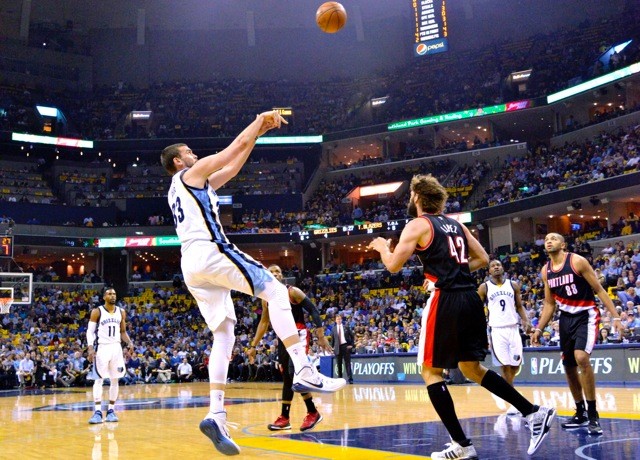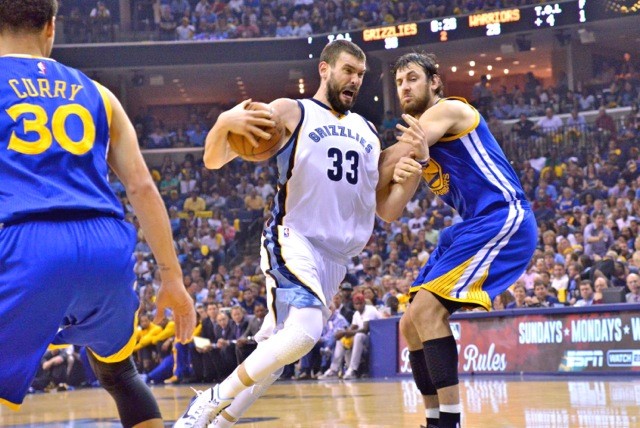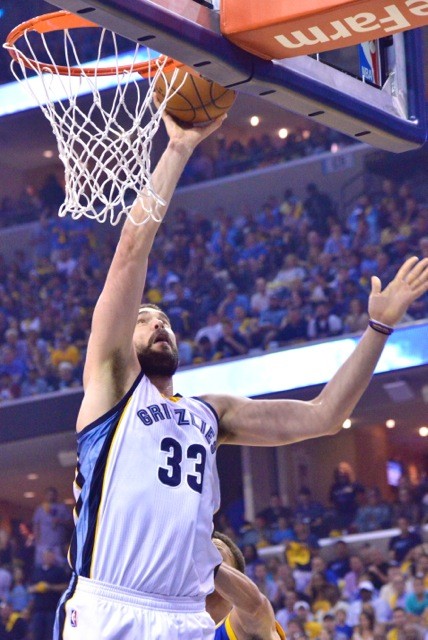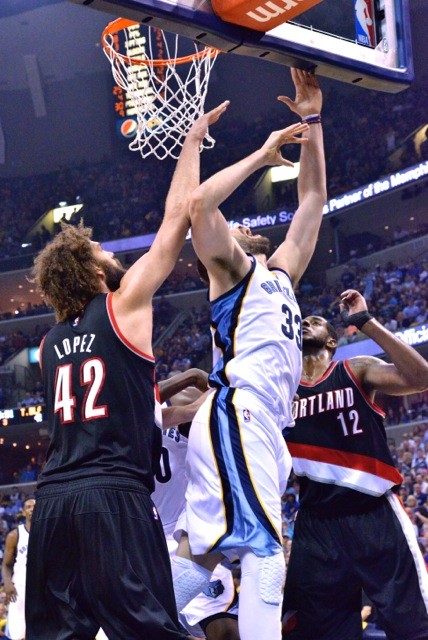 Larry Kuzniewski
Larry Kuzniewski
Note: I’m out of town at a conference this week, so I asked my good friend Andrew Ford if he wanted to guest post. Andrew was on my staff at Grizzly Bear Blues and you can find his stuff at Grizzly Bear Blues, Upside & Motor, Today’s Fastbreak, and InRecruit these days. (He stays busy, obviously.) He’s got a great basketball mind, and I’ve learned a lot about hoops just by bouncing things off him. —KL
Passivity is a dirty word uttered in many situations — often about Marc Gasol — over the course of Grizzlies games. When used, the word is certainly not meant to compliment Gasol’s play on the court. Rather, it implies that he is not doing what he should be doing, or more accurately what he is capable of doing.
There still might not be a better two-way center in the NBA than Gasol despite his struggles this season, but balanced performance on both ends is not always sexy nor is it what people believe to be the limit of his capabilities.
It’s not as if Gasol doesn’t have ample opportunity to impose his will on games. Nobody in the league averages more elbow touches per game (13.4) and only two players average more post touches per game (8.2) per NBA.com’s player tracking database. With those touches comes great responsibility though, and Gasol knows it. The offense flows through him more now than it ever has given the slow, steady decline of his frontcourt partner Zach Randolph and a backcourt constantly hamstrung by lack of creativity.
Serving as the fulcrum of an NBA offense is no small task, but Gasol fills the role as well as anybody in the league. He directs traffic with ease, guides teammates into good positions, and essentially hands the ball to them on a silver platter to get buckets.
However, playing that pivotal role might have unintended consequences. This is strictly speculation, but it could be putting Gasol in the wrong state of mind to dominate. An inherently unselfish player, Gasol has proven countless times that he is going to look to pass first when given the opportunity.
He knows the team needs his court vision and passing ability, which makes it difficult for him not to think of passing as his first option when the ball is in his hands. It’s not always a bad thing for Gasol to play the role of a pass-first focal point, but it can frequently be a problem because shooting often seems like a very distant second choice for Gasol even as he has reached the height of his offensive powers. A mental shift is long overdue.
To be completely fair to Gasol, he has posted more dominant stat lines over the past two seasons than the rest of his career combined. Eight of his nine thirty-point outbursts over the course of his career came in the 2014-15 season and the current 2015-16 campaign. These recent displays of scoring prowess are why more is desired — almost expected — from Gasol at the offensive end.
 Larry Kuzniewski
Larry Kuzniewski
True to His Word
Recently against the New York Knicks, Gasol scored 37 points on 29 attempts. This performance came after he told Peter Edmiston of Sports 56 WHBQ / 87.7 FM and the Commercial Appeal that he will take 25 shots during a game if the team needs him to do that to win.
So what if Gasol kept his word, played consistently in attack mode, and used more of those advantageous touches he so often gets for himself? How much different would the offense look if he chose to be aggressive and attempted to dominate on a nightly basis rather than choosing to flash his offensive brilliance a handful of times per season?
It might be helpful to start with some historical data. After seven-and-change seasons with the Grizzlies, there is a decent amount of data that demonstrates how well the Grizzlies have performed in the past when Gasol has scored above his average.
Over the course of his tenure with the Grizzlies, the team is 69-32 when he scores at least 20 points, 18-8 when he scores 25 or more, and a convincing 8-1 when he scores 30 or more per basketball reference. Small sample size warning, but just this season the Grizzlies are 8-3 when Gasol has scored at least 20 points.
One might think that Gasol looking for his own shot more would be detrimental to the flow of the offense and hurt his passing, but the stats show just the opposite. Gasol is averaging 3.8 assists per game this season, and he has averaged 3.9 assists in the 10 contests in which he scored more than 20 points this season. There’s no notable drop off in Gasol’s passing because his aggressiveness actually creates better spacing which results in cleaner passing lanes.
During games in which Gasol is on autopilot, slinging the ball around the court while not looking to score a ton, defenses can afford to sit back and stay home on assignments because they have played the game long enough to pick up on tendencies like Gasol wanting to pass above all else.
This is a key reason why defenses have not had to work very hard against the Grizzlies this season. Per SportVU, Memphis’ offense forces the least defensive movement in terms of feet per 24 seconds of any team in the league. As it turns out, it’s very easy to watch the ball be delivered to Gasol and sit back while he methodically tries to pick out a pass when there is hardly anything happening in the way of quality actions on the wing which could result in freeing a shooter.
A shift in how defenses play the Grizzlies when Gasol is aggressive is notable. When he’s looking to fire a midrange jumper from the elbow or to make a move to the rim as soon as he receives the ball in the post, defenses are forced to react quicker which often leads to scrambling. Perimeter defenders have to dig down another foot into the paint or stunt another foot towards the elbow while bigs have to worry more about executing a hard double in the post to force the ball out of Gasol’s hands. The extra few feet an aggressive Gasol creates is a boost the Grizzlies’ mediocre offense regularly needs.
 Larry Kuzniewski
Larry Kuzniewski
Lineups Matter
Another way an attack-first version of Gasol would make the offense more efficient is by creating more easy points in the way of free throws. Gasol is averaging 4.8 free throw attempts per contest this season, but he has averaged 8.2 attempts from the line in games in which he has scored more than 20 points this season. Gasol is great at drawing contact on graceful up-and-under moves and on his patented sweeping hook shot, so it makes sense that he gets to the line a lot more when he’s more aggressive and takes more shots.
An 84% free throw shooter, Gasol could feast off of an extra 3-4 attempts per game. It could be the difference in winning a couple more games throughout the course of the grueling regular season, which is huge when home court advantage matters so much in a brutal Western Conference.
Of course, all of this is context dependent. You can’t simply throw Gasol out on the court with any unit and hope that him having a score-first mentality will have the same result across all lineups. He would be best-served to play most of his minutes with lineups with quality shooters — something the Grizzlies unfortunately have a dearth of — and no traditional big men aside from himself to maximize spacing and unlock his full potential.
Gasol playing in lineups like the ones aforementioned don’t just give him more space to operate from the high and low post. When the Grizzlies can play a four out-one in offense with Gasol as the one guy playing inside, there is infinitely more room for Mike Conley and Gasol to team up and run the high pick-and-roll. This is important not just because it’s a really tough play to defend, but also because Gasol is naturally more inclined to shoot in the pick-and-roll because he’s not meant to be a primary distributor in those situations.
A more low-key benefit to the Grizzlies offense that could come by way of a regularly aggressive Gasol is additional offensive rebounding. The Grizzlies offensive rebound rate of 23.8 puts them 17th in the league in that category. Gasol attacking on more of his post touches could easily lead to more points on putbacks by himself or teammates like Tony Allen or Randolph who typically crash the glass hard.
 Larry Kuzniewski
Larry Kuzniewski
What About Defense?
One concern that often gets thrown out during the early stages of any conversation about Gasol trying to do more offensively is that his defense might suffer. Given his ongoing struggle with conditioning this season, putting more pressure on him offensively could realistically tank his defensive impact, but I don’t think history necessarily bears that out.
For one, Gasol has averaged 2.2 blocks in games this season in which he has scored at least 20 points. That’s almost one more than he has averaged in all games this season (1.3). Blocks alone don’t make a great rim protector, but assuming Gasol is in shape (maybe a big if) then he should have no problem leading the defense from the baseline while also stepping his game up some offensively.
It’s difficult to envision Gasol fully embodying an attack-first mentality for the rest of this season despite the fact that it would provide the team with a significant boost, but that’s something we could see a lot more of as the Grizzlies enter a potential rebuilding phase over the next couple of seasons.
Finesse, grace, elegance, poise, and power all equally mark Gasol’s beautiful offensive game, and the Grizzlies undoubtedly wish Gasol would start to fully utilize all five qualities every night as a new, unknown phase of the franchise is ushered in.
We’ve seen Gasol dominate on the offensive end with an arsenal of moves — both of the face up and post up variety — that few other big men possess. It might be a pipe dream, but when you know he is capable of dominating, it will always be tough not to think about what this team could be if he chose to dazzle with his knack for attacking more often.